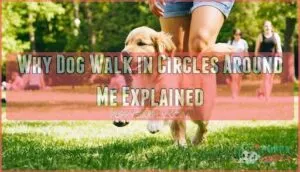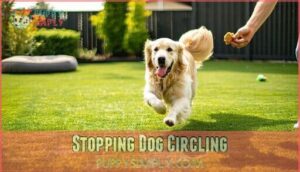This site is supported by our readers. We may earn a commission, at no cost to you, if you purchase through links.

It’s not just for fun—your furry companion might circle due to excitement, inherited habits, or to check the area for comfort and safety.
Sometimes, this behavior is their way of saying, “You’re my person,” blending a pinch of instinct, a dash of playfulness, and maybe even a sprinkle of stress relief.
Occasionally, dogs circle to pick up scents or adjust to temperature changes, much like fluffing a pillow before sleeping.
Stick around, and you’ll get the straight scoop on what your dog’s telling you, and understand the meaning behind their actions, which can be a sign of comfort.
Table Of Contents
- Key Takeaways
- Dog Circling Behavior
- Why Dogs Walk Circles
- Causes of Circling
- Addressing Circling Behavior
- Stopping Dog Circling
- Frequently Asked Questions (FAQs)
- What does it mean when a dog spins in circles when they see you?
- Why does my dog keep pacing around me?
- Can circling indicate a new type of communication?
- Does breed affect how often dogs circle humans?
- Are certain dog ages more prone to circling?
- Can diet changes influence a dogs circling habits?
- Is night-time circling around owners common?
- Conclusion
Key Takeaways
- Your dog circles you to show excitement or affection, making you the center of their attention.
- Sometimes, circling comes from instinct or their breed’s natural herding habits.
- If your dog suddenly circles more or looks stressed, pain or a medical issue might be the cause, so check with your vet.
- Circling before settling down can mean your dog’s checking for comfort, temperature, or scent, just like their wild ancestors did.
Dog Circling Behavior
You’re probably wondering why your dog walks in circles around you, and this understanding is vital to recognize that this behavior can be caused by various factors.
As you observe your dog’s circling behavior, you’ll want to ponder possible reasons, such as excitement, dominance, or hereditary instincts, to better address this issue.
Excitement
You notice your dog circling around you due to excitement triggers.
- Playful circling
- Breed predisposition
- Attention seeking
- Hyperactivity signs
Dog circling behavior indicates enthusiasm, not dominance, when they spin around you.
Dominance
You see dog circling behavior as a display of dominance, related to Alpha Theory and Pack Mentality, where dogs assert control and establish social hierarchy, possibly due to Resource Guarding, reflecting their Leadership Styles and dominance.
However, this behavior could also be a display of affection, or even related to instinctive herding behaviors.
Hereditary Behavior
You observe your dog’s circling behavior, which may be due to breed predisposition and genetic influence.
Driven by instinctual drives and trait inheritance with evolutionary roots, explaining why dogs circle around you, a natural dog behavior, influenced by genetic influence.
Pain or Stress
Sometimes, what looks like a quirky habit is actually a sign your dog isn’t feeling their best. Pain indicators and anxiety triggers can cause dog circling anxiety.
Sometimes your dog’s circling isn’t just cute—it’s their way of telling you they’re stressed or in pain.
You might notice behavioral changes, signaling discomfort.
- Comfort seeking
- Stress relief
- Dog circling medical
- Dog circling compulsion
If you suspect pain or stress, it’s time to investigate. Is there a new stressor? Could it be dog circling neurological? A vet visit can rule out underlying issues.
Ancestral Instincts
You’re witnessing your dog’s wild dog ancestry, where pack behavior and den preparation instincts kick in, explaining the dog circling instinct, a leftover from evolutionary roots.
Even as your dog spins, ancient den-making instincts from wild ancestors come alive right before your eyes.
Influencing dog behavior, particularly before lying down, as they spin around you, is a notable aspect of this instinct, showcasing how their ancestral traits still influence dog behavior.
Why Dogs Walk Circles
You’re wondering why dogs walk circles around you.
Circling reasons can be attributed to breed tendencies, pack mentality, and sensory input.
Dogs, especially puppies, may spin around due to excitement or hereditary behavior.
When a dog walks circles, it could be seeking comfort or trying to make sense of its environment.
Neurological issues can also cause this behavior, as seen in the link to Neurological issues.
Understanding dog behavior explanation is key to addressing why your dog spins around you.
By recognizing these factors, you can better comprehend your dog’s actions and provide the necessary care and attention, helping to reduce circling behavior and strengthen your bond with your pet.
This understanding will help you address the issue with proper care.
Causes of Circling
You’re probably wondering why your dog walks in circles around you, and this understanding is vital to comprehend the causes of this behavior.
By exploring the possible reasons, such as scent, comfort, or medical conditions, you can better address your dog’s circling behavior and strengthen your bond with them, which is a key aspect of understanding and improving your relationship through comfort.
Scent
You notice your dog spins around you due to scent marking, leaving pheromone trails through olfactory communication, using scent glands, with breed differences influencing this behavior.
A key dog circling reason and aspect of dog behavior explanation, especially when a dog circling before lying down, a form of dog circling communication.
Comfort
You see your dog walking circles, seeking comfort, perhaps reducing anxiety.
They might prefer a specific bedding spot, or be seeking social comfort and affection, explaining dog circling behavior as a way to create a safe space before lying down.
Temperature
You notice your dog circling due to temperature.
Here are reasons:
- Panting Threshold
- Breed Sensitivity
- Surface Temperature
- Hydration Levels
consider cooling methods to prevent dog circling excitement or attention seeking behaviors related to heat.
Medical Conditions
You’re concerned about your dog spinning around you.
Medical conditions like neurological issues, inner ear problems, or joint pain can cause dog circling.
Skin allergies and cognitive decline are also potential dog circling reasons, making it essential to consult a vet to determine the underlying cause of your dog’s behavior.
Behavioral Issues
You may notice your dog spins around you due to anxiety triggers or compulsive circling, which can be attention-seeking behavior, especially in breed predispositions or cognitive decline cases.
Affecting dog circling reasons and communication, including tail language, when your dog circling around you demands attention.
Addressing these issues might require understanding underlying dog behaviour problems.
Addressing Circling Behavior
You’re likely wondering how to address your dog’s circling behavior, and understanding the underlying causes is key.
By consulting a vet, avoiding reinforcement, and providing diversion, you can help your dog stop walking in circles around you.
Consult a Vet
If your dog spins around you, consult a vet for a medical evaluation to rule out underlying issues.
They may recommend diagnostic testing or a behavioral referral, discussing medication options and providing a clear explanation for why your dog is circling, addressing communication and attention concerns.
Avoid Reinforcement
When your dog spins around you, ignore circling to break the pattern.
Redirect attention to positive alternatives, providing a consistent response to dog circling attention and play, and avoid reinforcing the behavior, helping to stop why dog circling happens, and improve dog circling communication.
Consistency is key, as inconsistent cues can confuse your dog.
Provide Diversion
You can redirect your dog’s focus by providing mental stimulation through interactive games, puzzle toys, and training commands, reducing dog circling attention and play, and enhancing dog circling communication, understanding why your dog spins around you.
These tools can be found on websites that sell engaging puzzle feeders.
Give Them Space
When your dog spins around you, give them space.
Respect boundaries to reduce dog anxiety.
Consider:
- Personal space
- Safe environment
- Calm demeanor, to create a peaceful atmosphere and stop dog circling behavior, promoting a calm communication and a clear explanation of why dogs walk in circles.
Stopping Dog Circling
You’re looking to stop your dog from circling around you, and understanding the reasons behind this behavior is key.
By identifying the cause, you can apply effective techniques, such as training, environmental changes, or stress reduction, to help your dog break this habit.
Training Techniques
You’ll use training techniques like Positive Reinforcement and Clicker Training to address dog circling.
| Method | Success Rate | Description |
|---|---|---|
| Clicker | 60% | Reduces circling |
| Positive Reinforcement | 85% | Increases compliance |
Train your dog with consistency. Many owners find success with clicker training tools, using methods like Clicker Training.
Environmental Changes
After practicing those training techniques, focus on your dog’s environment.
New Surroundings, Weather Effects, and Seasonal Changes can spark behaviors like dog spins around me or dog circling greeting.
Sudden shifts might boost territory marking or trigger anxiety. For some dogs, anxiety relief products can help manage these triggers.
Watch for patterns—maybe a windy night or fresh bedding sets off the dog circling tail routine or dog circling play.
Why? Environmental changes matter, and understanding them can help you address behaviors like dog circling.
For example, recognizing the impact of Seasonal Changes and Weather Effects can be crucial in managing your dog’s behavior.
Reducing Stress
When life gets hectic and your pup starts dog circling greeting you, it’s time to lower their stress.
Try these:
- Offer a Safe Space away from noise.
- Identify Anxiety Triggers and minimize them.
- Stick to Routine Importance for daily predictability.
- Practice Calming Techniques during dog spins around me episodes.
- Reward calmness with Positive Reinforcement.
Increasing Exercise
A solid exercise routine goes a long way in curbing dog circling dominance. Adjust the exercise duration and activity variety to fit breed differences—some pups need more than others.
Keep a regular training schedule, and never forget dietary needs. Mental stimulation techniques can also tire puppies.
Consistent movement helps answer the question, “why?” when tackling dog circling training, revealing causality behind persistent circling behaviors.
Frequently Asked Questions (FAQs)
What does it mean when a dog spins in circles when they see you?
Did you know nearly 60% of dogs greet their owners by spinning around?
When your dog does this, they’re excited, showing affection, and sometimes trying to get your attention—a happy, wiggly “hello” just for you!
Why does my dog keep pacing around me?
Your dog likely paces around you to get your attention, burn off nervous energy, or stick close for comfort.
It’s a canine way of saying, “I’m here, let’s hang out!” or needing reassurance.
Can circling indicate a new type of communication?
Think of your pet’s movements as their way of drawing invisible circles of attention.
If your dog starts circling more, it could signal a new type of communication, showing excitement, seeking reassurance, or even attempting to guide you somewhere.
Does breed affect how often dogs circle humans?
Breed definitely plays a part—herding dogs like Border Collies may circle more often, while laid-back breeds tend to relax instead.
If your pup’s circling ramps up, it’s likely part of their breed’s working instincts.
Are certain dog ages more prone to circling?
If your pup spun any more, you’d think it was chasing its own tail.
Puppies and senior dogs circle more often—puppies for play or learning, seniors possibly from age-related issues.
Always watch for changes in circling behavior, as this can be an indicator of underlying issues, and seniors may require special attention.
Can diet changes influence a dogs circling habits?
Changing what you feed your furry friend can play a role in their circling habits; sometimes, irritation, allergies, or digestive discomfort prompt that spinning.
Adjusting the diet might help, but a vet’s advice never hurts, and understanding the cause of the spinning is crucial to making informed decisions about your pet’s diet.
Is night-time circling around owners common?
Like clockwork, you might notice your dog circling you at night—yes, that’s common.
Instinct tells them it’s time to get cozy, seek reassurance, or check their space before settling in beside you for sleep.
Conclusion
Picture your dog’s paws gently circling around you, each step a sign of instinct, comfort, or curiosity.
When you’re wondering why dog walk in circles around me, remember they’re expressing excitement, checking their surroundings, or sometimes even hinting at a need for attention or relief.
By understanding these behaviors, you’ll notice subtle cues and know when action is needed, which helps in guaranteeing your dog’s well-being, strengthening your bond and enhancing your shared moments together.













